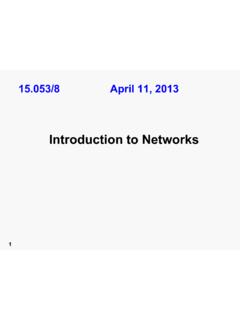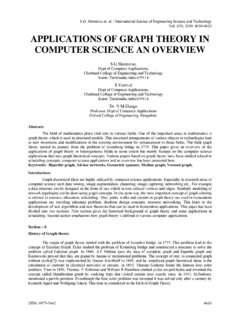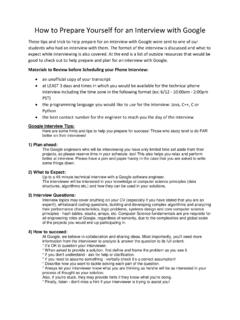Transcription of The Traveling Salesman problem
1 The Traveling Salesman problem Amanur Rahman Saiyed Indiana State University Terre Haute, IN 47809 , USA. April 11, 2012. Abstract The Traveling Salesman problem , deals with creating the ideal path that a Salesman would take while Traveling between cities. The solution to any given TSP would be the Shortest way to visit a finite number of cities, visiting each city only once, and then returning to the starting point. We also must assume that if there are two cities, city A and city B for example, it costs the same amount of money to travel from A to B as it does from B to A. For the most part, the solving of a TSP is no longer executed for the intention its name indicates. Instead, it is a foundation for studying general methods that are applied to a wide range of optimization problems. Contents 1 Statement Of The problem 2. 2 History of The TSP 2.
2 3 Solution methods of TSP 3. Exact Solutions .. 3. Brute force method .. 3. Example for Brute Force Technique .. 4. Branch and Bound .. 5. 4 Approximate solutions 5. Nearest Neighbor .. 5. Example for Nearest Neighbor Method .. 6. Greedy .. 7. 5 Optimization Techniques 8. 2-opt and 3-opt .. 8. Example for 2-opt Technique .. 9. 1. THE Traveling Salesman problem 2. 1 Statement Of The problem The Traveling Salesman problem involves a Salesman who must make a tour of a number of cities using the shortest path available and visit each city exactly once and only once and return to the original starting point. For each number of cities n ,the number of paths which must be explored is n!, causing this problem to grow exponentially rather than as a polynomial. There are bunch of algorithms offering comparably fast running time and still yielding near optimal solutions.
3 2 History of The TSP. The Traveling Salesman problem (TSP) is a problem whose solution has eluded many mathematicians for years. Currently there is no solution to the TSP that has satisfied mathematicians. Historically, mathematics related to the TSP was developed in the 1800's by Sir William Rowan Hamilton and Thomas Penyngton Kirkman, Irish and British mathemati- cians, respectively. Hamilton was the creator of the Icosian Game in 1857. It was a pegboard with twenty holes that required each vertex to be vis- ited only once, no edge to be visited more than once, and the ending point being the same as the starting kind of path was eventually re- ferred to as a Hamiltonian , the general form of the TSP. was first studied by Karl Menger in Vienna and Harvard in the late 1920's or early 1930's. TSP?s were first studied in the 1930?s by mathematician and economist Karl Menger in Vienna and Harvard.
4 It was later investigated by Hassler Whitney and Merrill Flood at Princeton. In 1994, Applegate, Bixby , Chvatal, and Cook solved TSP containing 7,397 cities. Later in 1998, they solved it using 13,509 cities in United States. In 2001, Applegate, Bixby, Chvtal, and Cook found the optimal tour of 15,112 cities in Germany. Later in 2004, TSP of visiting all 24,978. cities in Sweden was solved; a tour of length of approximately 72,500. kilometers was found and it was proven that no shorter tour exists. This is currently the largest solved TSP. THE Traveling Salesman problem 3. Table 1: Summarizes the Milestones of TSP. Year Research Team Size of instance 1954 G. Dantzig, R. Fulkerson, and S. Johnson 49 cities 1971 M. Held and Karp 64 cities 1975 Camerini, L. Fratta, and F. Maffioli 67 cities 1977 M. Grotschel 120 cities 1980 H. Crowder and Padberg 318 cities 1987 M.
5 Padberg and G. Rinaldi 532 cities 1987 M. Padberg and G. Rinaldi 2,392 cities 1994 David , Robert , Vasek Chvatal, and William J. Cook 7,397 cities 1998 David , Robert , Vasek Chvatal, and William J. Cook 13,509 cities 2001 David , Robert , Vasek Chvatal, and William J. Cook 15,112 cities 2004 David , Robert , Vasek Chvatal, and William J. Cook 24,978 cities 3 Solution methods of TSP. Introduction Suppose a salesperson needs to travel from a city to all the other cities exactly once to sell his products and return back to the city he started from. He wants to do this while covering the minimum total distance. How can he do that? This is where solving the TSP comes in. Some solution methods of TSP include: Exact Solutions Brute-force method. Branch and Bound. Brute force method When one thinks of solving TSP, the first method that might come to mind is a brute-force method.
6 The brute-force method is to simply generate all possible tours and compute their distances. The shortest tour is thus the optimal tour. To solve TSP using Brute-force method we can use the following steps: Step 1. calculate the total number of tours. Step 2. draw and list all the possible tours. THE Traveling Salesman problem 4. Step 3. calculate the distance of each tour. Step 4. choose the shortest tour, this is the optimal solution. Example for Brute Force Technique 3. A B. 5. 10. 2 9. D C. 1. Here, there are 4 nodes. There is a possibility of the following 3 paths 3 3. A B A B. 5 5. 2 9 2 9. 10 10. D C D C. 1 1. A B C D A = 15 A B D C A = 19. THE Traveling Salesman problem 5. 3. A B. 5. 2 9. 10. D C. 1. A C B D A = 26. The best distance path is A B C D E A , of value 15. Branch and Bound The Branch and Bound strategy divides a problem to be solved into a number of sub-problems.
7 It is a system for solving a sequence of sub- problems each of which may have multiple possible solutions and where the solution chosen for one sub- problem may affect the possible solutions of later sub-problems. Step 1: Choose a start node. Step 2: Set bound to a very large value, let's say infinity. Step 3: Choose the cheapest arc between the current and unvisited node and add the distance to the current distance and repeat while the current distance is less than the bound. Step 4: If current distance is less than bound, then we are done Step 5: Add up the distance and bound will be equal to the current distance. Step 6: Repeat step 5 until all the arcs have been covered. 4 Approximate solutions Nearest Neighbor. Greedy approach. Nearest Neighbor This is perhaps the simplest and most straight forward TSP heuristic. The key to this algorithm is to always visit the nearest city, then return THE Traveling Salesman problem 6.
8 To the starting city when all the other cities are visited. Nearest Neighbor, O(n2 ). Step 1. Select a random city. Step 2. Find the nearest unvisited city and go there. Step 3. Are there any unvisited cities left? If yes, repeat step 2. Step 4. Return to the first city. Example for Nearest Neighbor Method This is the step-wise approximate solution by nearest neighbor method. This case has 5 nodes. We start with the node A and perform the nearest neighbor algorithm. 13 13. A B A B. 2 4 5 9 2 4 5 9. 21 21. D 9 C D 9 C. 1 1. 7 21 7 21. E E. 13 13. A B A B. 2 4 5 9 2 4 5 9. 21 21. D 9 C D 9 C. 1 1. 7 21 7 21. E E. THE Traveling Salesman problem 7. 13 13. A B A B. 2 4 5 9 2 4 5 9. 21 21. D 9 C D 9 C. 1 1. 7 21 7 21. E E. 13. A B. 2 4 5 9. 21. D 9 C. 1. 7 21. E. The total distance of the path A D C B E A obtained using the nearest neighbor method is 2 + 1 + 9 + 9 + 21 = 42.
9 Greedy Greedy algorithm is the simplest improvement algorithm. It starts with the departure Node 1. Then the algorithm calculates all the distances to other n 1 nodes. Go to the next closest node. Take the current node as the departing node, and select the next nearest node from the remaining n 2 nodes. The process continues until all the nodes are visited once and only once then back to Node 1. When the algorithm is terminated, the sequence is returned as the best tour. Greedy, O(n2 log2 (n)). THE Traveling Salesman problem 8. 5 Optimization Techniques Once a tour has been generated by some tour construction heuristic, we might wish to improve that solution. There are several ways to do this, but the most common ones are the 2-opt and 3-opt local searches. Their performances are somewhat linked to the construction heuristic used. 2-opt and 3-opt The 2-Opt algorithm was first proposed by Croes [1958], although the basic move had already been suggested by Flood [1956].
10 The 2-opt algo- rithm basically removes two edges from the tour, and reconnects the two paths created. This is often referred to as a 2-opt move. The 3-opt algorithm works in a similar fashion, but instead of removing two edges we remove three. A 3-opt move can actually be seen as two or three 2-opt moves. We finish our search when no more 3-opt moves can improve the tour. If a tour is 3-optimal it is also 2-optimal. When talking about the complexity of these k-opt algorithms, one tends to omit the fact that a move can take up to O(n) to naive implementation of 2-opt runs in O(n2 ),this involves selecting an edge (c1 , c2 ) and searching for another edge (c3 , c4 ), completing a move only if dist(c1 , c2 ) + dist(c3 , c4 ) > dist(c2 , c3 ) + dist(c1 , c4 ). Figure 1: 2-Opt move THE Traveling Salesman problem 9. Figure 2: 2-Opt move Figure 3: 3-Opt move Figure 4: 3-Opt move Example for 2-opt Technique Assume that this is the solution obtained from nearest neighbor method or some kind of approximation method.







